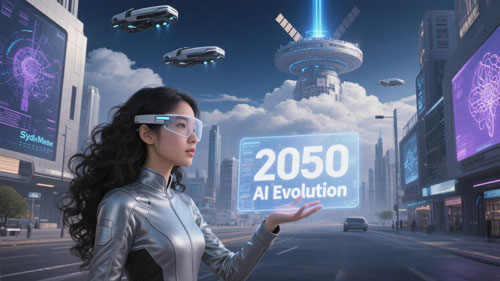Artificial intelligence has evolved from a specialized technology to what industry experts now call the "connective tissue of modern business and society." As we move through 2025 and look toward the next decade, several converging forces are reshaping the AI landscape, from the emergence of autonomous "agentic" systems to increasingly sophisticated multimodal models.
From Large Language Models to Multimodal Systems
If 2023-2024 belonged to large language models, then 2025 is the year of large

multimodal models (LMMs) – systems that can ingest and generate text, code, images, audio, and video within a single architecture 9. Companies are racing to develop systems that support text, image, audio, and video real-time interaction that can be deployed on terminal hardware like smartphones.
These advancements are made possible by unified token spaces that allow a voice prompt to yield an executable 3D scene or a spreadsheet of insights, and context windows exceeding one million tokens that make it feasible to load entire codebases or film scripts for dynamic editing.
The Rise of Agentic AI
Autonomous or "agentic" AI represents one of the most significant shifts in artificial intelligence. These systems not only generate content but also plan multi-step tasks and execute them with minimal human intervention. Gartner positions agentic AI as the #1 strategic technology trend for 2025, noting these systems will increasingly handle complex workflows from IT ticket resolution to marketing campaign orchestration and even procurement negotiations.
The real breakthrough will come when agentic systems gain robust self-evaluation loops, enabling them to triage their own failures before escalating to humans. This is when "co-worker" stops being a metaphor and becomes reality.
The Move Toward Smaller, Specialized Models
Counter-intuitively, 2025 is seeing a surge in special-purpose and small language models (SLMs) trained on curated domain corpora. These require orders of magnitude fewer parameters yet often outperform general models in niche tasks such as medical reasoning or contract analysis.
This trend represents a shift toward what experts describe as a bifurcated market: mega-models reserved for creative synthesis, and compact SLMs embedded everywhere from MRI scanners to point-of-sale terminals. Open-weight releases mark a deliberate pivot toward local inference for cost, privacy, and latency gains.
Edge AI and On-Device Processing
Edge deployments are exploding as organizations confront the twin pressures of data sovereignty and energy cost. Specialized hardware like Apple's neural engines, Qualcomm's Hexagon processors, and Nvidia's Jetson Orin modules exemplify the trend toward on-device inference capabilities.
The business upside includes inference latency measured in microseconds and no data egress fees. McKinsey's 2024 AI survey shows 65% of companies using AI in at least two functions, a figure expected to soar as edge AI unlocks previously offline use-cases like predictive maintenance in remote oil fields or real-time language translation in AR glasses.
AI Hardware and Efficiency Advances
Significant progress is being made in developing specialized AI hardware that dramatically improves efficiency. Some companies have achieved remarkable efficiency gains, such as reducing dual-node deployment costs by 57 times through lightweight models that can run on single cards in terminal equipment.
These advancements are making AI more accessible and sustainable by reducing the computational resources required for training and inference. As hardware continues to improve, we can expect AI capabilities to become available in increasingly diverse environments and applications.
The Path Toward Artificial General Intelligence
The AI industry is increasingly focused on the development of artificial general intelligence (AGI). Most experts agree that multimodal capabilities are essential for achieving AGI. As one expert noted, "From the essence of intelligence, it is necessary to associate various modal information across modalities".
However, significant technical challenges remain. Current multimodal models still struggle with spatial reasoning problems that are simple for young children, indicating that we're still in the early stages of development toward true AGI. Most current systems rely primarily on language-based reasoning even when processing multimodal inputs, limiting their capabilities in areas requiring spatial understanding.
Ethical Considerations and Regulatory Frameworks
As AI becomes more powerful and pervasive, ethical considerations and regulatory frameworks are gaining increased attention. Governments and industry bodies are working to establish guidelines and standards for responsible AI development and deployment, focusing on issues such as privacy, bias, transparency, and accountability.
The coming years will likely see increased regulatory activity around AI, particularly in areas such as content authentication, privacy protection, and accountability for AI-driven decisions. Companies that proactively address these concerns will be better positioned to navigate the evolving regulatory landscape.
The Future of AI: Integration and Ubiquity
Looking forward, AI is poised to become increasingly integrated into every aspect of technology and business. Rather than existing as separate systems or features, AI will become embedded in the fabric of software applications, physical devices, and business processes.
As this integration deepens, we'll see AI capabilities become less visible as distinct features while becoming more powerful in their effects. The most successful implementations will be those that seamlessly enhance human capabilities without requiring conscious interaction with "AI" as a separate entity.
About Our Company: We are a research and development organization focused on advancing artificial intelligence technologies and their practical applications. Our team works at the forefront of AI innovation, collaborating with industry partners to develop solutions that address real-world challenges.
For more information about our AI research and development initiatives, visit our website or contact our research team.
Contact Person: David
Tel: 13118683999
E-mail:wangcx28@21cn.com /info@yo-yo.net.cn
WhatsApp:13118683999
Post time: Aug-22-2025



